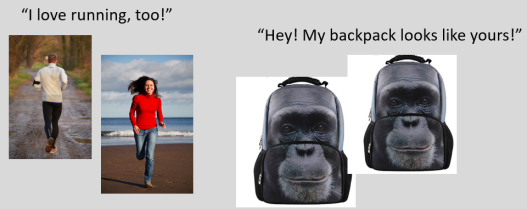
(This posting includes a handout link at the end of this post which you are welcome to use with your students.) *
Early in one term, I was starting a conferencing session with a new student, Anja. As she was sitting down next to me, she said, “David, I heard that you grew up in Chicago. I just had a homestay there!” I noticed that I immediately felt a connection to Anja that stayed with me from that day on.
There is some amazing research that explains how we make connections with others. And best of all, there are ways that we can apply this to building positive relationships with our students.
In their book Click: The Power of Instant Connections the authors, Ori and Rom Brafman, describe some enlightening experiments. In one study, some people volunteered for a made-up study about creativity. The researchers secretly set it up so that as half the volunteers left the researchers’ lab, someone wearing a badge with the same first name as the volunteers approached them asking for a donation to a charity. For example, if Cindy had just left the lab, she would be approached by a charity worker wearing a name tag that showed that her name, also, was Cindy. Likewise, Susan would meet someone named Susan. The other half of the subjects were approached by someone with no badge. Now this is what I found remarkable. The first group whose same first names were on badges donated twice as much as the second group who saw a badge with a different name.
In a similar experiment, researchers asked people if they would be willing to participate in a time-consuming study. When the researchers shared the same birth date as the person, 62% agreed to participate, but only 33% agreed when they didn’t have the same birth date.
According to the authors, similarity leads to greater likability. And it doesn’t matter what the similarity is. Others will perceive the person as part of their in-group if they share common traits that differentiate them from others.
In addition, the quality of the similarity isn’t important; it’s the number of similarities that matters. The more similarities you have, the stronger the connection.
How to apply this to our classrooms
I think it’s safe to say that feeling a connection between our students and us can bring great benefits to us and them. And as the studies above have illustrated, any kind of similarities that we can find between us and them will likely result in connectiveness.
Whenever I’ve had a chance to point out some similarity between a student and me (for example, when as they are arriving to class or leaving, or during a break, or as with Anja, during a conference) I try to recall some simple thing I overheard them say, or something they wrote or just an observation. Some examples:
- Saori is from Japan. I said to her, “When I lived in Nagoya, one of my best student’s name was Saori.”
- I told Alejandra, “AlejandraI, I read in your essay that you love horses. I’m planning to go horseback riding during our next vacation.”
- I noticed Elio was wearing the same color shirt as I was. Pointing to my shirt and his, I said, “Hey, Elio. It looks like we are on the same team.”
- And finally, I used this technique with “troublemaker” Shawn. He came to my class with a reputation. The day after getting their first assignment, I put his paper next to something I had written and said, “Shawn, it looks like you and I have similar handwriting. Look how we both write our “d”s, “p”s …” A week later, I told him, “I overheard you say that you drive a Toyota. I do too. How do you like yours?” The next day, when he came to class, he showed me some pictures of his. I can’t prove that it was because of this technique, but I can say that I never had any “trouble” with Shawn.
For a short reading unit about this topic that you can use with your students, see • 6th Free ESL Reading Unit. Click: The Power of Similarities (Names)
David Kehe
*About the free-download materials. During my 40 years of teaching ESL, I have had many colleagues who were very generous with their time, advice and materials. These downloads are my way of paying it forward.